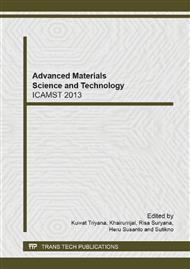p.95
p.100
p.104
p.108
p.112
p.116
p.122
p.126
p.134
Chelating Agent Role in Synthesizing Cerate-Zirconate Powder by a Sol-Gel Method
Abstract:
In this study, powders of BaCe0.54Zr0.36Y0.1O2.95 (BCZY) were synthesized by a sol-gel method assisted with three different groups of chelating agents. The chelating agents used were citric acid, tartaric acid, glycolic acid from carboxylic group, tryelthylenetetraamine (TETA) from polyamino group, nitriloaacetic acid (NTA) and ethylenediaaminetetraacetic acid (EDTA) from polyamino carboxylic group. The samples were dried at 325 °C and calcined at a series of temperatures. The solution and resulting powder properties were studied using Fourier transform Infrared (FTIR) spectroscopy. FTIR spectra showed all the samples exhibit different characteristics of absorption bands after being treated at various temperatures. Such behavior indicates that the chelation process took place before the formation of metal oxide. The chelating agent from polyamino group that consists of N-donor atoms, which is TETA showed no characteristics peak of carbonates was detected after the sample was calcined at 1100 °C. Therefore, TETA gave a significant role in reducing calcination temperature for synthesizing cerate-zirconate powder.
Info:
Periodical:
Pages:
112-115
Citation:
Online since:
February 2014
Authors:
Keywords:
Price:
Сopyright:
© 2014 Trans Tech Publications Ltd. All Rights Reserved
Share:
Citation:


